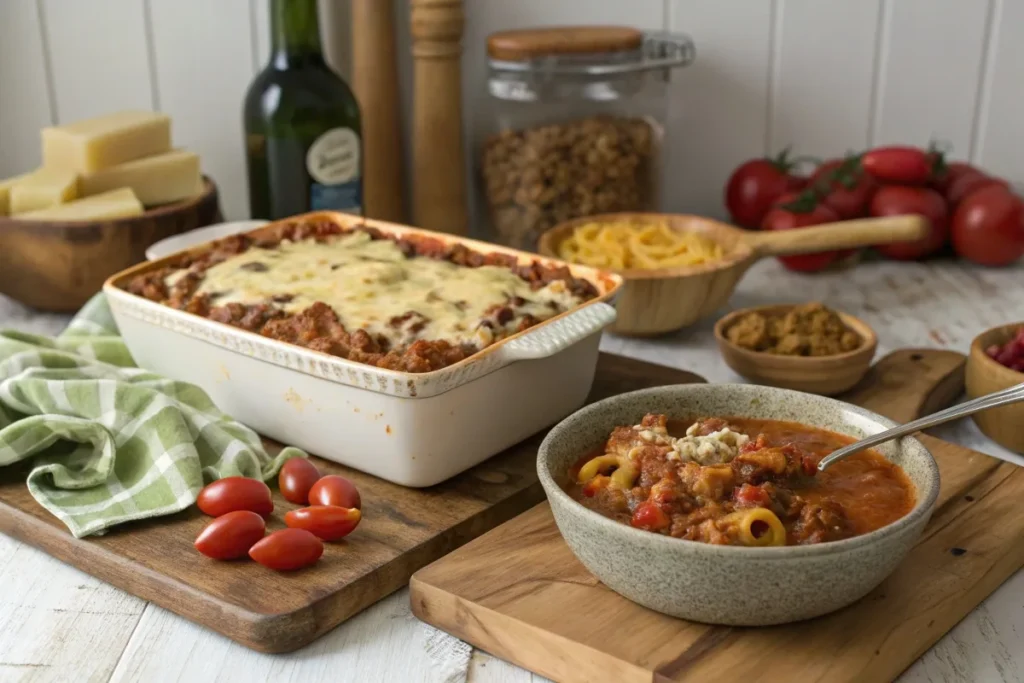Are beefaroni and goulash the same thing? It’s a question that has sparked many dinner table debates and recipe discussions. At first glance, these two hearty dishes might seem interchangeable, both offering a comforting mix of pasta, meat, and sauce. But dig a little deeper, and you’ll find distinct differences that make each one unique. First, beefaroni is the ultimate quick and simple comfort food, loved for its ease and kid-friendly appeal. Goulash, on the other hand, brings rich, complex flavors with its roots in traditional Hungarian cooking. Also, both dishes are incredibly versatile, making them perfect for busy weeknights or cozy family meals. You’re going to love exploring how these recipes differ and how to decide which one suits your taste. Keep reading to uncover the secrets behind their ingredients, origins, and flavor profiles. Who knows? You might even be inspired to try both and decide your favorite!
Table of contents
Defining Beefaroni and Goulash
Key Ingredients of Beefaroni
Beefaroni is a classic comfort dish with simple yet satisfying ingredients. It typically includes pasta, ground beef, and a tomato-based sauce. First, elbow macaroni is the pasta of choice, offering a soft, chewy base. Then, ground beef provides a rich and hearty protein element, making the dish filling. The sauce, often a blend of tomato paste, canned tomatoes, and mild spices like garlic powder, adds flavor without overwhelming the palate. Cheese, such as shredded cheddar, is sometimes mixed in for extra creaminess. Beefaroni is quick to prepare, making it a go-to meal for busy families. Unlike goulash, beefaroni is straightforward and doesn’t rely on complex seasoning or slow cooking. It’s the perfect dish when you need something tasty and easy.

Traditional Elements of Goulash
Goulash, on the other hand, is a hearty dish rooted in Hungarian tradition. It features slow-cooked beef, onions, and paprika as key components. The beef is often seared first to enhance its flavor. Then, it’s simmered with onions and a flavorful broth, allowing the ingredients to meld together beautifully. Paprika, both sweet and smoked, gives goulash its distinct warm flavor and vibrant red color. Potatoes or pasta are sometimes added to create a more filling meal. Unlike beefaroni’s quick prep, goulash requires time and care to develop its rich, layered flavors. This makes it a meal worth savoring, perfect for colder days or special family gatherings.
Exploring the Cultural Origins of Both Dishes
The American Roots of Beefaroni
Beefaroni has its roots in American kitchens, where it became a household staple. It gained popularity in the mid-20th century for its affordability and ease of preparation. First, families embraced it as a quick and hearty meal that could feed many on a budget. Then, canned versions, like those from Chef Boyardee, made it even more accessible. Over time, beefaroni evolved into a nostalgic comfort food, loved for its simplicity. While it doesn’t have the deep cultural history of goulash, beefaroni reflects the American spirit of practicality and creativity in the kitchen.

Goulash’s Rich Hungarian Heritage
Goulash, on the other hand, boasts a storied history dating back centuries in Hungary. It originated as a shepherd’s meal, cooked over open fires in large cauldrons. First, its hearty ingredients made it ideal for sustaining workers. Then, the introduction of paprika in the 18th century elevated its flavor, turning it into a national treasure. Today, goulash is a symbol of Hungarian cuisine, celebrated for its robust spices and comforting warmth. Unlike beefaroni, goulash tells a story of tradition, showcasing Hungary’s culinary heritage with every bite.
Comparing Flavor Profiles and Cooking Techniques
Beefaroni’s Simple, Comforting Appeal
Beefaroni is loved for its simple and familiar flavors. The mild tomato-based sauce is slightly tangy, balancing perfectly with the savory ground beef. First, it’s seasoned with basic spices like garlic powder and black pepper, ensuring it’s kid-friendly and universally appealing. Then, the tender pasta soaks up the sauce, creating a cohesive and satisfying dish. Its cooking method is straightforward, requiring just a stovetop or oven. Unlike goulash, beefaroni doesn’t demand much time or effort, making it ideal for busy weeknights or casual dinners.

Goulash’s Complex Spices and Rich Flavors
Goulash offers a rich, layered flavor profile that sets it apart. Paprika, the star ingredient, brings warmth and depth, while other spices like caraway seeds enhance its complexity. First, the beef is slow-cooked, allowing it to become tender and flavorful. Then, the broth absorbs the spices, creating a savory, aromatic dish. Goulash takes longer to prepare than beefaroni but rewards you with a meal full of bold, comforting flavors. It’s a dish that feels special, perfect for savoring on a cozy evening.
How These Dishes Have Evolved Over Time
Variations of Beefaroni Across Generations
Beefaroni has adapted over time to suit changing tastes and lifestyles. Originally a simple pasta and meat dish, modern versions include creative twists. First, vegetables like bell peppers or spinach are often added for a nutritional boost. Then, alternative proteins like turkey or plant-based options make it accessible for diverse diets. Sauces have also evolved, ranging from spicy marinara to creamy cheese blends. These variations keep beefaroni fresh and exciting, ensuring it remains a beloved comfort food while catering to contemporary preferences.
Modern Twists on Traditional Goulash
Goulash has also embraced innovation while staying true to its roots. Chefs experiment with different meats, such as pork or lamb, to create new variations. First, vegetarian versions replace beef with beans or lentils, offering a plant-based alternative. Next, some recipes incorporate wine or unique spices for added depth. Despite these changes, the essence of goulash—a hearty, slow-cooked stew—remains intact. Unlike beefaroni, goulash evolves more subtly, balancing modern trends with its rich culinary heritage.
Can You Substitute One Dish for the Other?
Situations Where Beefaroni Works Best
Beefaroni excels in situations where quick, satisfying meals are needed. Its mild flavors and simple preparation make it a favorite for families with kids. First, it’s perfect for weeknight dinners or school lunches. Then, its budget-friendly ingredients ensure it’s accessible to everyone. While it lacks the bold spices of goulash, beefaroni shines in its ability to deliver comfort and convenience, making it the better choice for everyday meals.
When Goulash Is the Perfect Choice
Goulash is ideal for occasions when you want a hearty, flavorful dish that feels special. Its rich spices and slow-cooked ingredients make it perfect for gatherings or cold-weather meals. First, the complexity of flavors impresses guests and satisfies cravings for something unique. Then, the warmth of the stew offers comfort, making it a great choice for cozy evenings. While beefaroni is practical, goulash delivers a depth of flavor and tradition that’s hard to match.
Frequently Asked Questions (FAQs)
What is the American name for goulash?
The American version of goulash is often called “American goulash” or “slumgullion.” It’s a simpler, more casual take on the traditional Hungarian dish. First, it combines ground beef, elbow macaroni, and a tomato-based sauce. Next, the spices are mild, typically garlic powder or paprika, instead of the bold flavors in Hungarian goulash. Unlike its European counterpart, American goulash is a one-pot meal that’s quick to make and budget-friendly. This version has become a comfort food staple, especially in Midwestern and Southern homes. You’re going to love how easy it is to prepare for weeknight dinners!
Are goulash and beefaroni the same?
Are beefaroni and goulash the same thing? Not exactly, though they share similarities. Both dishes feature pasta and meat as key components. First, beefaroni is typically made with ground beef, elbow macaroni, and a tomato-based sauce. Meanwhile, goulash often includes slow-cooked beef and a rich, paprika-spiced broth. Next, beefaroni has a simpler flavor profile, making it a kid-friendly favorite. Goulash, on the other hand, offers a more complex and hearty taste. They’re both delicious but cater to different cravings. Why not try both and see which one wins your heart?
Why do Americans call it goulash?
Americans call their version “goulash” as a nod to the Hungarian original, though the dishes are quite different. First, Hungarian goulash is a slow-cooked stew made with chunks of beef, paprika, and vegetables. Over time, Americans simplified the recipe, creating a quicker, pasta-based dish. Then, the name stuck, even though the flavors and ingredients evolved. Today, “American goulash” is a comfort food staple with its own unique identity. It’s a fun twist on a classic recipe that’s easy to customize. You’re going to love how it bridges tradition and convenience in one delicious meal!
What is another name for goulash?
Another name for goulash is “pörkölt” in Hungary, which refers to a meat stew similar to the traditional dish. First, Hungarian goulash is often confused with pörkölt because both use paprika and slow-cooked beef. In America, goulash is also called “American chop suey” in some regions, especially in New England. This name highlights its fusion of ingredients and casual appeal. These variations show how goulash has been reimagined across cultures. No matter what you call it, the dish’s hearty flavors and comforting warmth make it a universal favorite!
Celebrating the Unique Qualities of Beefaroni and Goulash
Beefaroni and goulash each bring their own charm to the table, offering something for every mood and craving. First, beefaroni’s simple ingredients and comforting flavors make it a timeless favorite for quick, satisfying meals. Meanwhile, goulash shines with its rich spices and hearty texture, creating a dish steeped in cultural history. Both are incredibly versatile, letting you adapt them to suit personal tastes or available ingredients. In addition, their differences highlight the creativity in cooking across regions and generations.
So, are beefaroni and goulash the same thing? Not at all, but that’s what makes them special. Whether you’re craving quick comfort or something with a bit of flair, each dish delivers something unique. Try them both and enjoy exploring the delicious world of pasta and hearty flavors. You’re going to love discovering the best of both these classics!
